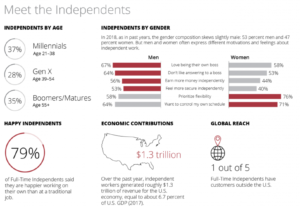For the 93rd month in a row, the U.S. has added payroll jobs to the economy. This trend has lowered the unemployment rate to just 4 percent and has contributed to the 6.7 million jobs currently open. With such a booming job market, it’s natural to think that independent work would see a decline as people choose the security and benefits of a full-time job. But as new research shows, the popularity of independent work is not slowing down – in fact, it’s quite the opposite.
Since 2011,our friends at Emergent Research have published the “MBO Partners State of Independence in America” study, which offers insights into the growth of the independent workforce. This year, a few key trends emerged:
- Traditional jobs aren’t going away. As mentioned above, the job market keeps growing, and there’s no sign of it slowing down for now. People who were working independently out of necessity now have the option to go back to a full-time job, which has contributed to the increase in satisfaction of those who remain independent by choice. 79 percent of full-time independent workers are happy in their occupations.
- Full-time independent work is becoming increasingly attractive for those with highly sought-after skills. According to the report, “companies are growing more comfortable working with independents, utilizing their skills in strategic positions, and paying them more.” The percentage of high-earning (more than $100,000 annually) independent workers has been rising steadily, from 12.5% in 2011 to 20.9% in 2018.
- Despite the wide availability of traditional jobs, economic necessity and the continued development of tools that facilitate independent work have contributed to the uptick in people seeking this type of work, especially as a side gig. “Those seeking new skills, pursuing passions, or combating wage stagnation are likely to test independence occasionally.” Almost fifteen percent of independent workers are classified as ‘occasional,” – an increase of 16.4% from last year.
- Combining traditional with independent work is the new normal. “More than 47 percent of the U.S. adult workforce reports either currently working or having worked as an independent at one time during their career.” By 2023, that figure will rise to 52 percent.
 Whether it’s by necessity or choice, independent work is now more ubiquitous than ever. And as the number of independents grows, so does their influence on the economy. Over the past year, they contributed more than $1.3 trillion annually, making up over 6.7 percent of the U.S. GDP. This means it’s increasingly important to take independent and gig workers into account when developing business policies and programs. They are the future of the American workforce, and the success of our economy rests on making sure it works for everyone.
Whether it’s by necessity or choice, independent work is now more ubiquitous than ever. And as the number of independents grows, so does their influence on the economy. Over the past year, they contributed more than $1.3 trillion annually, making up over 6.7 percent of the U.S. GDP. This means it’s increasingly important to take independent and gig workers into account when developing business policies and programs. They are the future of the American workforce, and the success of our economy rests on making sure it works for everyone.
